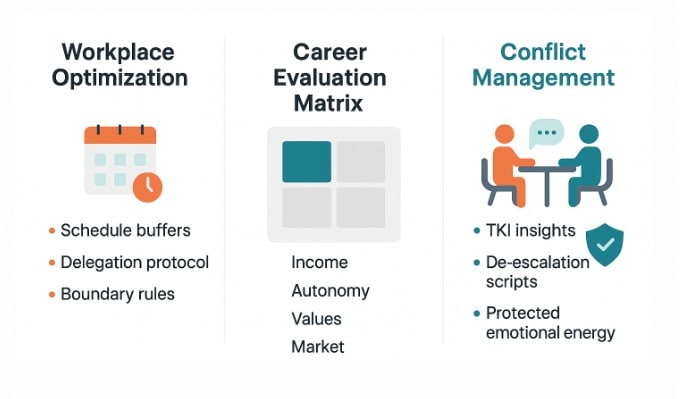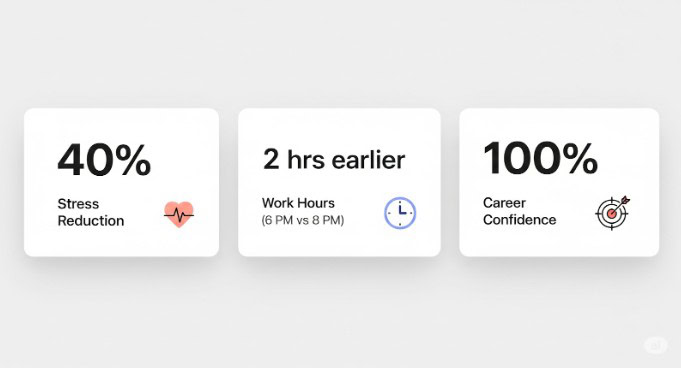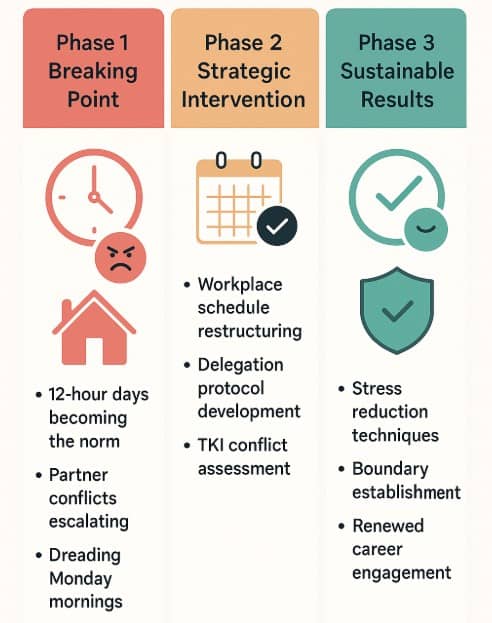
How a Private Practice Attorney Overcame Partner Conflict and Burnout to Reclaim Career Satisfaction
The Challenge: Sarah’s moment of clarity came during yet another tense partner meeting that had stretched past 7 PM. As one of four attorney-owners in a thriving practice, she found herself caught between two crushing forces: the relentless demands of clients and escalating conflicts with a difficult partner that were making every workday feel like walking through a minefield.
The symptoms of burnout were unmistakable. Twelve-hour days had become the norm, not the exception. And what should have been collaborative partner discussions often devolved into stress-inducing confrontations. The emotional toll was bleeding into her personal life, leaving her questioning whether two decades of legal expertise were leading to a dead end.
The financial stakes were significant—as a practice owner, walking away meant abandoning substantial equity and partnership benefits. But the personal cost of staying seemed equally devastating. She was facing the classic lawyer dilemma: endure unsustainable stress in a lucrative position, or risk financial security for peace of mind. The tipping point came when she realized she was dreading Monday mornings for the first time in her career, prompting her to seek professional guidance before making any irreversible decisions.
The Solution: Rather than immediately exploring exit strategies, the coaching approach focused on a dual-track strategy: optimizing her current situation while simultaneously evaluating alternatives. This comprehensive framework prevented knee-jerk reactions while building sustainable solutions.

The immediate intervention centered on workplace optimization. Through detailed analysis of her typical day, we identified specific stress triggers and developed targeted mitigation strategies. This included restructuring her client schedule to create buffer time, renegotiating responsibilities, and establishing clearer boundaries between legal functions and administrative tasks. Critical to success was implementing a systematic delegation protocol, empowering her legal assistants and office staff to handle routine tasks that had been consuming valuable attorney time.
The conflict management component proved equally crucial. Using the Thomas-Kilmann Conflict Mode Instrument (TKI) assessment, we identified her natural conflict style and its mismatch with her difficult partner’s approach. Armed with this insight, she learned specific techniques to de-escalate tensions, reframe confrontational conversations, and protect her emotional energy during unavoidable conflicts.
Simultaneously, we developed a comprehensive career evaluation matrix that included income requirements, lifestyle preferences, professional autonomy, values alignment, and market viability. This framework allowed her to objectively assess both her current role and potential alternatives—from legal contract work to consulting to completely different industries where her analytical skills, legal knowledge, and leadership experience would transfer effectively.
The strategy also incorporated stress-reduction techniques and boundary-setting practices that she could implement immediately, providing relief while longer-term solutions developed.
The Results: Within six weeks of implementing the workplace optimization strategies, Sarah reported a 40% reduction in her stress levels and she was leaving the office by 6 PM most days instead of 8 PM. The conflict management techniques proved transformational—partner meetings became manageable rather than dreaded, and she felt equipped to engage professionally without absorbing emotional toxicity.

Most significantly, the systematic approach revealed that her current position, when properly managed, actually aligned well with her career criteria. The combination of reduced stress, improved work-life boundaries, and effective conflict navigation eliminated the urgent need for a career pivot while preserving her options for future transitions.
She chose to continue coaching support for six months to reinforce these new practices and maintain her alternative career research as a form of professional insurance. The result was not just reduced burnout, but renewed engagement with the practice of law and confidence in her ability to shape her career proactively rather than reactively. Her practice partners noticed the positive change, and client satisfaction scores improved as her stress levels decreased.
The Transformation at a Glance

Three-Phase Journey Phase 1: Breaking Point
- 12-hour days becoming the norm
- Partner conflicts escalating
- Dreading Monday mornings
- Personal life suffering
Phase 2: Strategic Intervention
- Workplace schedule restructuring
- Delegation protocol development
- TKI conflict assessment
- Career criteria matrix
Phase 3: Sustainable Results
- Stress reduction techniques
- Boundary establishment
- Conflict management mastery
- Renewed career engagement
Measurable Results in 6 Weeks
| Metric | Result | Impact |
| Stress Reduction | 40% | Dramatically improved daily experience |
| Work Hours | 2 hours earlier departure | 6 PM vs 8 PM finish time |
| Career Confidence | 100% clarity | Clear path forward established |
Key Strategic Insights
- Optimize Before Exit: Systematic workplace improvements often resolve issues that initially seem to require dramatic career changes.
- Dual-Track Strategy: Improving current conditions while researching alternatives creates psychological safety and prevents panic decisions.
- Conflict Competency: Learning to navigate difficult relationships effectively multiplies career options and reduces workplace stress.
- Objective Criteria: Using systematic evaluation frameworks ensures career moves align with priorities rather than temporary frustrations.
